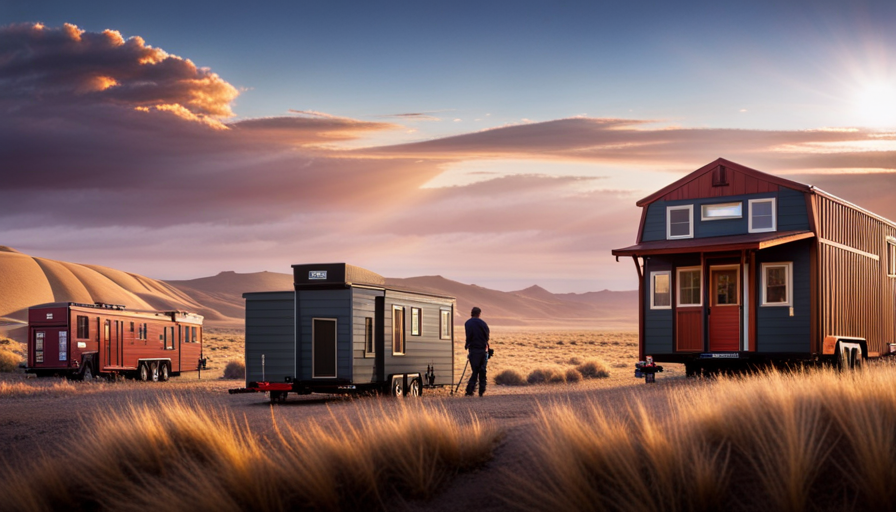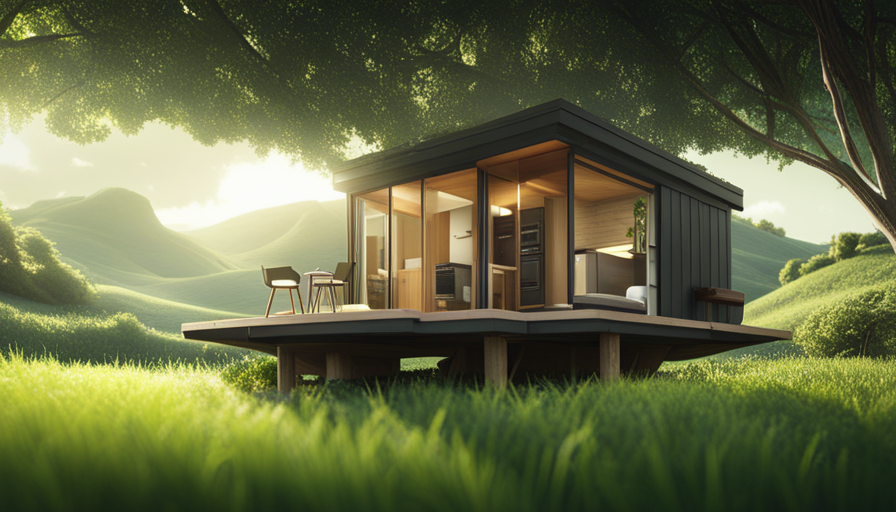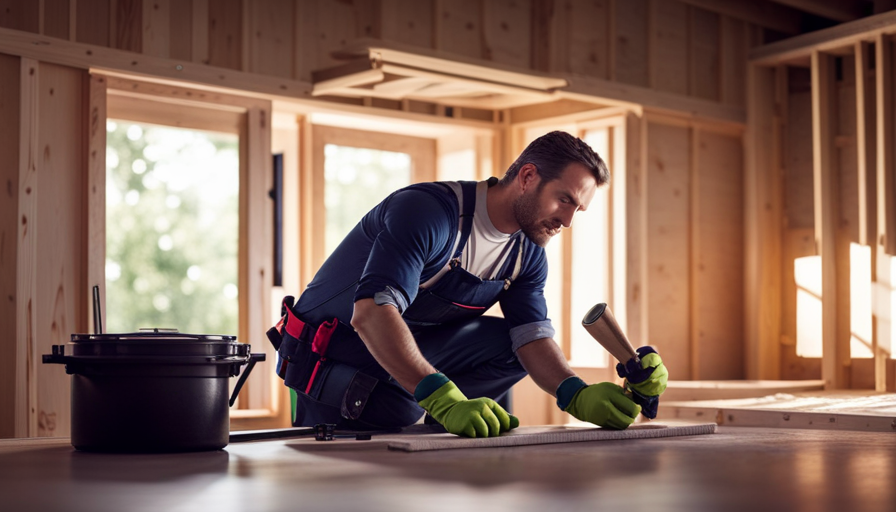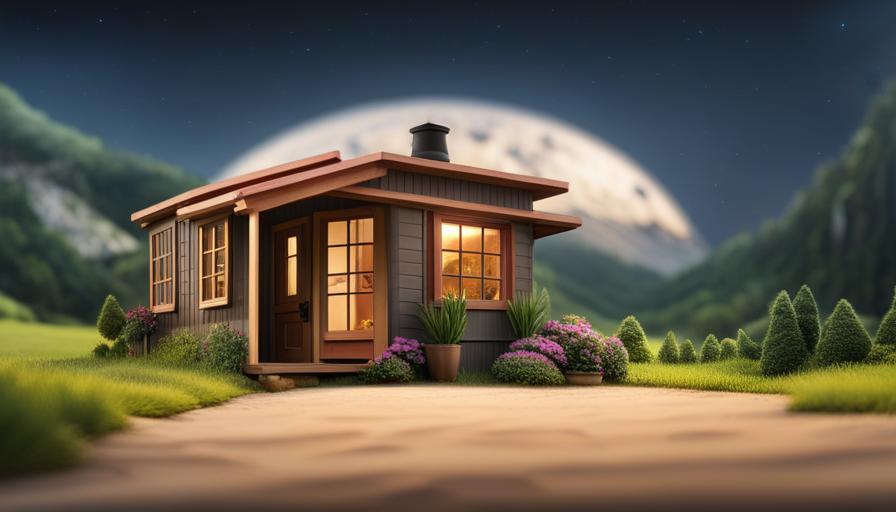Have you ever wondered about the true dimensions of Tumbleweed Tiny House? Prepare to be amazed as I uncover the fascinating world of this innovative company.
Tumbleweed Tiny House has been revolutionizing the housing industry for years, and their impact on the tiny house movement cannot be overstated. With their unique and customizable designs, Tumbleweed Tiny House has captured the hearts of homeowners all over the world.
But it’s not just their designs that set them apart; it’s also the team of skilled professionals behind the scenes. From architects to engineers, each member of the Tumbleweed Tiny House team brings their expertise to create truly remarkable homes.
And it’s not just homeowners who are singing their praises; industry leaders have also recognized their talent, leading to exciting collaborations and partnerships.
So, join me as we delve into the history, growth, and future plans of Tumbleweed Tiny House. Get ready to be inspired by their incredible journey and the homes they create.
Key Takeaways
- Tumbleweed Tiny House is a leader in the tiny house movement and has revolutionized the housing industry.
- The company was founded in 1999 by Jay Shafer and offers innovative and customizable designs for tiny houses.
- Tumbleweed Tiny House prioritizes the use of sustainable and eco-friendly materials in the construction process.
- The company has a team of skilled professionals, including architects, designers, carpenters, and electricians, who create a range of floor plans and features to suit different needs and preferences.
History and Evolution of Tumbleweed Tiny House
The history and evolution of Tumbleweed Tiny House is quite fascinating! Tiny house enthusiasts have been captivated by the company’s innovative and customizable designs since its inception.
Tumbleweed Tiny House was founded in 1999 by Jay Shafer, who had a vision of living simply and sustainably. His passion for tiny houses led him to create a company that would cater to the growing demand for these unique dwellings. Over the years, Tumbleweed Tiny House has become a leader in the tiny house movement, inspiring individuals to downsize and embrace a minimalist lifestyle.
Tiny house communities have sprouted up across the country, with people coming together to share ideas and experiences. The company’s commitment to quality craftsmanship and attention to detail has made Tumbleweed Tiny House a trusted name in the industry.
Moving on to the next section, let’s explore their innovative and customizable designs.
Innovative and Customizable Designs
When it comes to the innovative and customizable designs of Tumbleweed Tiny House, one of the key points to consider is the range of floor plans and features they offer. Whether you’re looking for a compact layout or a more spacious design, Tumbleweed has options to suit your needs.
Additionally, Tumbleweed is committed to using sustainable and eco-friendly materials in their construction, making their tiny houses not only functional and stylish but also environmentally conscious.
Range of Floor Plans and Features
With a myriad of floor plans and features, Tumbleweed Tiny House is a treasure trove of customizable options for those seeking a compact yet luxurious living experience. Tumbleweed offers a wide range of sizes, ensuring that there is a perfect fit for everyone. Whether you’re looking for a cozy 150 square feet retreat or a more spacious 400 square feet home, Tumbleweed has you covered.
In addition to the range of sizes, Tumbleweed offers unique features that make each tiny house truly one-of-a-kind. From loft bedrooms and skylights to built-in storage solutions and energy-efficient appliances, Tumbleweed combines functionality and style in every design. These customizable options allow homeowners to create a space that reflects their personal taste and needs.
Transitioning to the next section, Tumbleweed also prioritizes the use of sustainable and eco-friendly materials in their construction process.
Sustainable and Eco-Friendly Materials
Choose sustainable and eco-friendly materials for your tiny house, and feel a sense of pride knowing that you are making a positive impact on the environment. At Tumbleweed Tiny House, we prioritize sustainable building practices to minimize our environmental impact. We believe in using materials that are renewable, non-toxic, and energy-efficient. Our team carefully selects each element of your tiny house, ensuring that it meets our high standards for sustainability. From the foundation to the roof, we use materials that are both durable and environmentally friendly. For example, our insulation is made from recycled materials, reducing waste and conserving energy. Additionally, we incorporate energy-efficient appliances and fixtures to further reduce your tiny house’s carbon footprint. By choosing Tumbleweed Tiny House, you can be confident that you are investing in a home that is not only beautifully designed but also environmentally responsible. Transitioning into the next section, let’s explore the skilled professionals and team behind Tumbleweed Tiny House.
Skilled Professionals and Team Behind Tumbleweed Tiny House
To truly appreciate the skilled professionals and team behind Tumbleweed Tiny House, you’ll be amazed by the diverse talents and expertise they bring to the table.
From architects and designers to carpenters and electricians, each member of the team plays a crucial role in creating these innovative and sustainable homes.
The architects ensure that the design maximizes space utilization while maintaining a pleasing aesthetic. The designers carefully select eco-friendly materials and incorporate energy-efficient features into the tiny houses.
The carpenters bring these designs to life, using their craftsmanship to construct sturdy and functional structures. Electricians ensure that the tiny houses are equipped with the necessary electrical systems for modern living.
Together, this team of skilled professionals works tirelessly to create homes that are not only beautiful but also environmentally conscious.
Transitioning into the subsequent section, their impact on the tiny house movement is undeniable.
Impact on the Tiny House Movement
Before diving into the impact of Tumbleweed Tiny House on the movement, it’s crucial to acknowledge the skilled professionals and team behind the company. They’re the driving force behind the success of Tumbleweed and they’ve made it what it is today.
Now, let’s shift our focus to the impact of Tumbleweed on the tiny house movement. The company has played a crucial role in popularizing the concept of tiny living and it’s inspired countless individuals to embrace a simpler, more sustainable lifestyle.
The economic impact of Tumbleweed can’t be understated, as it has created job opportunities for builders, designers, and suppliers in the tiny house industry. However, it’s important to note that affordability challenges still exist for many people interested in tiny living.
Despite this, Tumbleweed’s innovative designs and commitment to quality have made tiny houses more accessible to a wider audience.
Moving forward, let’s explore some customer testimonials and success stories to gain further insight into the impact of Tumbleweed Tiny House.
Customer Testimonials and Success Stories
Imagine stepping into your dream home, a cozy and sustainable sanctuary that perfectly embodies your values and lifestyle. At Tumbleweed Tiny House Company, customer satisfaction is our top priority. We take pride in hearing about our customers’ real-life experiences and how our tiny houses have impacted their lives. Here are some testimonials and success stories that showcase the joy and fulfillment our customers have found in their Tumbleweed homes:
| Customer Name | Location | Testimonial |
|---|---|---|
| Sarah Thompson | Seattle, WA | "Living in my Tumbleweed house has been a game-changer. I feel more connected to nature and have drastically reduced my carbon footprint." |
| John Rodriguez | Austin, TX | "I was skeptical at first, but Tumbleweed exceeded my expectations. The craftsmanship and attention to detail are remarkable. I couldn’t be happier." |
| Emily Collins | Portland, OR | "My Tumbleweed house has allowed me to live a simpler life, free from the burden of a mortgage. It’s the perfect blend of functionality and beauty." |
| Mark Peterson | Denver, CO | "I love the sense of community that comes with living in a Tumbleweed village. It’s amazing how much you can connect with your neighbors in such a small space." |
| Lisa Johnson | Asheville, NC | "The Tumbleweed team was incredibly helpful throughout the entire process. They made my dream of owning a tiny house a reality." |
These customer testimonials highlight the real-life experiences and satisfaction that Tumbleweed Tiny House Company brings to its customers. Our commitment to quality and sustainable living has made us a leader in the tiny house movement. As we continue to grow, we are excited to collaborate and partner with other industry leaders to further enhance the tiny house experience for our customers.
Collaboration and Partnerships with Other Industry Leaders
I was truly inspired by the customer testimonials and success stories I read about Tumbleweed Tiny House Company. It’s incredible to see how their houses have transformed people’s lives and provided them with a simpler, more sustainable lifestyle.
But what caught my attention next was their collaboration and partnerships with other industry leaders. Tumbleweed Tiny House Company actively seeks partnership opportunities and industry collaborations to enhance their products and services. They understand the importance of working together to create even better solutions for their customers.
To give you an idea of their collaborative efforts, here are five notable partnerships they have formed:
- Partnership A: With a leading solar energy company to provide eco-friendly power solutions.
- Partnership B: With a renowned interior design firm to create stunning, functional interior spaces.
- Partnership C: With a well-known sustainable materials supplier to ensure high-quality, environmentally-friendly construction.
- Partnership D: With a popular home automation company to offer cutting-edge smart home features.
- Partnership E: With a national furniture retailer to provide stylish and space-saving furniture options.
These collaborations truly set Tumbleweed Tiny House Company apart and open up exciting possibilities for future growth and expansion plans.
Future Growth and Expansion Plans
Little did we know that our humble beginnings would pave the way for a future filled with exponential growth and expansion plans. As we continue to establish ourselves as leaders in the tiny house industry, our sights are set on the future market and international expansion.
With the increasing demand for sustainable and affordable housing solutions, we see immense potential for growth in the coming years. Our goal is to reach more customers around the world and make our innovative designs and high-quality craftsmanship accessible to a global audience.
Through strategic partnerships and collaborations, we aim to expand our presence in new markets and introduce our brand to a diverse range of customers. The future holds exciting opportunities for Tumbleweed Tiny House, and we’re enthusiastic about our plans for growth and expansion.
Frequently Asked Questions
How long has Tumbleweed Tiny House been in business?
Tumbleweed Tiny House has been in business for over 20 years, making it one of the pioneers in the tiny house movement. Its longevity speaks to the company’s success and impact on this growing trend.
Tumbleweed Tiny House has played a significant role in popularizing the concept of living in small, sustainable homes. Its designs and products have inspired countless individuals to downsize and embrace a simpler, more environmentally-friendly lifestyle.
What materials are typically used in the construction of Tumbleweed Tiny Houses?
In the construction of Tumbleweed tiny houses, sustainable building materials are typically used. These materials are chosen for their eco-friendly properties, such as being renewable and non-toxic. Tumbleweed also employs cost-effective construction methods, which allow for efficient and affordable building processes.
By combining sustainable materials and cost-effective techniques, Tumbleweed is able to provide environmentally friendly tiny houses that are both affordable and durable.
How does Tumbleweed Tiny House ensure the quality and safety of their homes?
Tumbleweed Tiny House ensures the quality and safety of their homes through a rigorous quality control process and obtaining safety certifications.
The quality control process involves thorough inspections at every stage of construction, from design to final build. Tumbleweed also ensures that all materials used in their homes meet industry standards.
Additionally, their homes are built to comply with safety regulations and certifications, providing customers with peace of mind regarding the safety of their tiny homes.
Are Tumbleweed Tiny Houses suitable for year-round living?
Living in a Tumbleweed tiny house year-round is like having a cozy haven in the midst of nature’s embrace. With top-notch insulation and a range of heating options, these homes ensure your comfort even during harsh winters. Tumbleweed is dedicated to providing a safe and sustainable living environment, so you can trust their commitment to quality. Whether you’re seeking simplicity or a sustainable lifestyle, Tumbleweed tiny houses are ideal for year-round living.
Can Tumbleweed Tiny Houses be customized to meet specific needs or preferences?
Yes, Tumbleweed Tiny Houses can be customized to meet specific needs or preferences. They offer a range of customization options and design flexibility, allowing individuals to personalize their tiny house according to their requirements.
From choosing the layout and size to selecting specific features and finishes, Tumbleweed provides the opportunity to create a unique and tailored tiny house that suits individual tastes and lifestyle.
Conclusion
In conclusion, Tumbleweed Tiny House isn’t just a company, it’s a movement. With its innovative designs and skilled team, they’ve made significant contributions to the tiny house industry.
Their customizable homes have captured the hearts of customers, leading to numerous success stories and testimonials. Through collaborations with other industry leaders, Tumbleweed continues to push the boundaries of what’s possible in the world of tiny homes.
As they look towards the future, their plans for growth and expansion promise to bring even more exciting developments to this thriving community.
Hi, I’m Emma. I’m the Editor in Chief of Tiny House 43, a blog all about tiny houses. While tree houses are often associated with childhood, they can be the perfect adult retreat. They offer a cozy space to relax and unwind, surrounded by nature. And since they’re typically built on stilts or raised platforms, they offer stunning views that traditional homes simply can’t match. If you’re looking for a unique and romantic getaway, a tree house tiny house might just be the perfect option.










